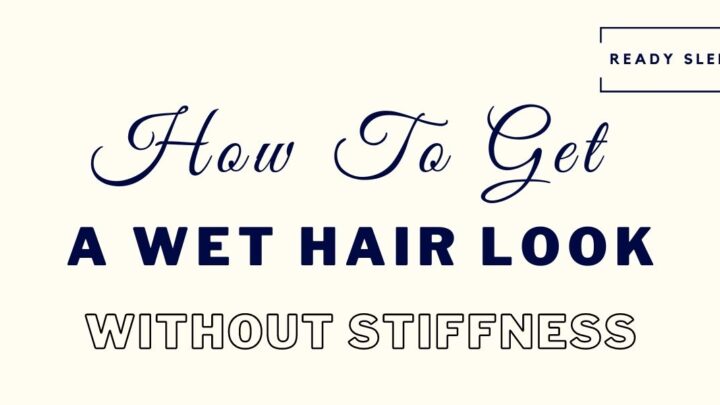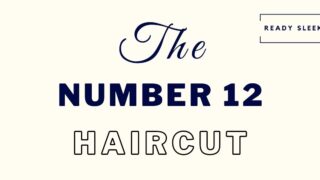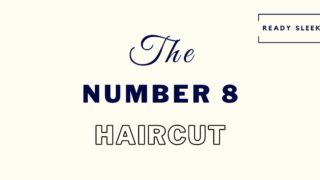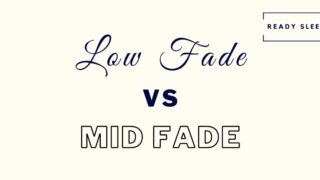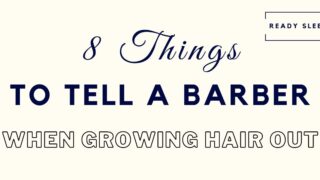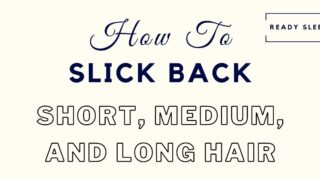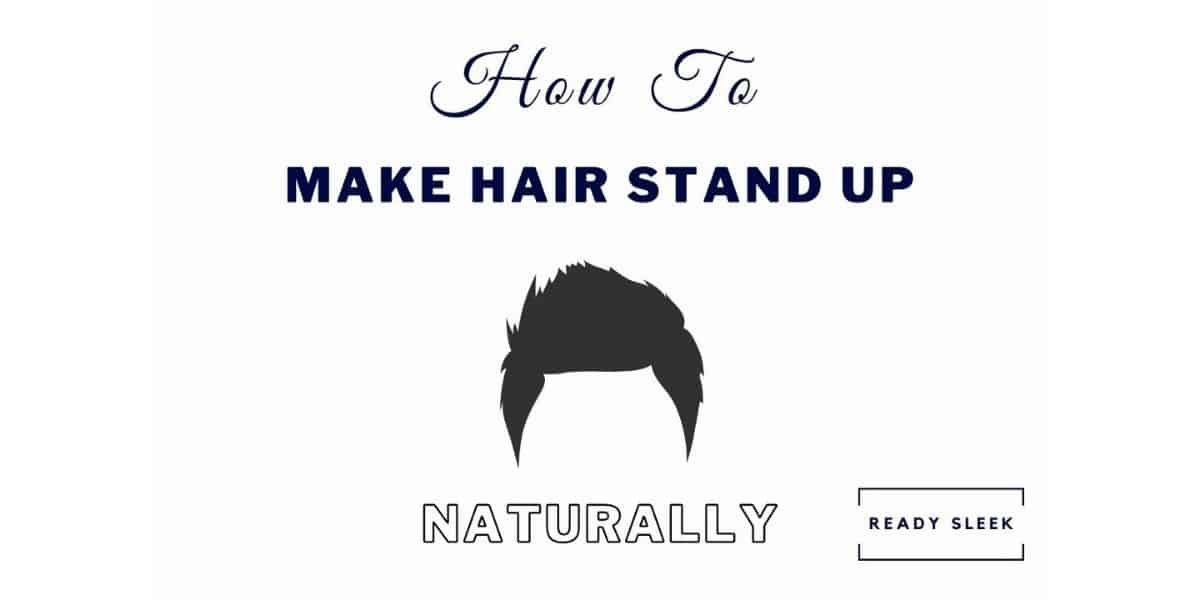Achieving that glossy, slick finish can be tough to get right. You need the right technique and the right products. You’re about to learn exactly how to get a wet hair look without stiffness.
Let’s get to it.
8 Ways To Get The Wet Hair Look Without Stiffness
These tips, tricks, and techniques should be used in combination to achieve the best wet hair look.

You don’t need to do all of them – but experiment to find those that work well for your specific hair.
1. Use A Conditioner
As tempting as it may be, you don’t want to let your hair get greasy and unclean.
Although “greasiness” can achieve a sort of wet hair look in its own right, it’s not the type of wetness you really want.
At the end of the day, it’ll look unclean and unwashed – that’s not ideal.
The greasiness and wetness we’re looking to get should be achieved by using the right techniques and the right products – not by simply keeping it unwashed.
Greasy hair is also more difficult to style and manage – it’ll be less responsive to your styling efforts.
So, wash it regularly and use shampoo to cleanse.
But don’t underestimate the use of a conditioner when trying to get a shinier end result. It won’t be enough to get that wet hair look on its own, by any means.
Conditioners will smoothen and moisturize. They’re great for counteracting the drying effects that shampoos can have.
But conditioners also add a bit of shine to the hair as well. A gentle shine – but it’ll definitely lay the foundation for the other tips in this list.
The softening effects should also reduce the stiffness of the end result.
After washing and conditioning, avoid using a blow dryer at this point. You’ll want to start styling damp hair as opposed to bone-dry hair.
Towel-drying the hair until it’s damp is better than drying it completely or leaving it soaking wet.
2. Start Styling With Damp Hair
When you want to make the hair look wet for long periods of time, starting with kinda wet hair to begin with is a good way to go.
It’s a trade-off.
Styling very wet hair is pretty impossible.
It’s heavy and won’t stay in place no matter how hard you try to style it. Once you do, it’ll probably look very different once it’s dry in any case.
Also, wet hair is prone to breakage. It’s vulnerable. So, avoid styling soaking wet hair.
Styling dry hair will generally give you a better hold. However, the hold will be stiffer and less wet-looking than if you were to style damp hair.
While damp hair won’t give you as good of a hold as dry hair would, the hold will be more pliable and less stiff. In addition, it’ll have a shinier edge to it as well.
Damp hair is still more vulnerable to breakage than dry hair, so you do still need to be careful when styling it.
But overall, starting off with damp hair will be the most likely way to achieve the pliable, glossy finish you’re looking for.
If you find that your hair becomes dry before or in the middle of styling, you can always top it up with a few spritzes of water from a spray bottle.
So, what do you use to style it?
3. Pre-Style The Right Way
A pre-styler is a product that’s applied before the actual styling begins, as the name suggests.
You could say that the ultimate aim of a pre-styler is to make the hair more responsive. In other words, more likely to do what you want it to when you actually start styling it.
The vast majority of people looking for a wet finish would want some added shine. That’s a given.
Those that want a smooth and straight finish with a gentle shine would be best off using a smoothing lotion as their pre-styler of choice.
Morrocanoil Smoothing Lotion (Amazon Link) is a good example.

Although it’s often used as a “blow dry lotion” and blow-dried quickly after application, when trying to get a wet hair look it’s usually best to delay blow-drying until later.
Letting it air dry or very gently blow-drying for a short period of time without letting the hair become completely dry before styling is a good option.
Remember, you want the hair to stay damp for when you properly style it afterward. We’re just pre-styling here.
You can always top up with a few sprays of water as well.
A pre-styler such as smoothing lotion is great for producing that soft and silky finish that really adds to a wet hair look.
If you’re looking for more of a “wet and wavy” finish, using a wave texturizing spray would be more appropriate than a smooth lotion.
But either way, making the hair more responsive should also reduce the amount of styling product you’ll need to use in the next step.
I’ve often found that the less product I need to use, the less stiff the hold is at the end.
4. Waxes And Oil-Based Pomades
The product you choose is crucial.
When you’re looking for a wet finish that isn’t stiff, you’ll want a shiny and pliable product.

Avoid those that give you a stiff hold.
This can be tricky to understand at first, but it helps that the main ways in which hair products can be categorized are in terms of shine and hold.
You want a medium to high shine – that’s simple enough. At the end of the day, trying to get a wet look with a matte product is going to be pretty tough.
But you also want a soft and pliable hold when you’re looking to avoid stiffness.
A pliable hold is one that can be restyled during the course of the day without the need for moisture or more product.
It doesn’t necessarily mean it’s a weaker hold. It just means it’s less crispy.
Products such as hair clays and pastes will generally give you a pliable hold that isn’t stiff. However, they’re usually matte or low shine and so won’t be of much use when trying to get a wet finish.
Two products that produce a shiny, soft, and pliable finish are hair waxes and oil-based pomades.
These products are glossy – great for defined and formal hairstyles such as slick backs, side parts, pompadours, and comb-overs.
They’re shiny and easy to restyle even several hours after applying them.
Oil-based pomades are usually heavier and tougher to apply than waxes. They can also be tough to wash out.
But when you’re looking for a super slick and shiny finish, oil-based pomades are a good way to go.
I usually think of hair wax as the little cousin of oil-based pomades. Not quite as hard to apply or wash out, but should still do the trick when you’re looking for a shiny and pliable hold.
5. Avoid Gels And Water-Based Pomades
Now that you know the products most likely to give you your desired finish, let’s talk through two products you should definitely avoid.
Although clays, pastes, and putties are unlikely to give you that wet, shiny finish you crave, at least they aren’t going to produce stiffness.
There are two products that are typically shiny but will often produce stiffness. They produce the crispy finish that you’re looking to avoid.
I’m talking about hair gels and water-based pomades.
These two products are water-based. They both have a smooth, gel-like consistency that emulsifies effortlessly between the palms and spreads through the hair like a dream with minimal resistance.
They’re also great for producing a wet and shiny finish.
The problem is the hold.
The hold with both hair gels and water-based pomades will almost always be stiff, although some will be stiffer than others.
Water-based pomades are sometimes called “glorified hair gels”, possibly unfairly.
Suavecito and Uppercut are two water-based pomades I use sometimes when I’m looking for a glossier finish in a hurry and can’t be bothered with the effort of applying an oil-based pomade.
Although it’s debatable, water-based pomades are generally less likely to cause flaking than hair gels. Some say that hair gels do also produce a stiffer hold than water-based pomades.
Having said this, there are plenty of higher-quality hair gels that produce very similar effects to your average water-based pomade.
The main point here is that these products are great for producing a wet hair look. But they’ll also usually produce a stiffness you won’t find acceptable.
It’s worth trying them out, however. The lower the quantity of these products you apply, the less stiff the hold will be.
If you find that applying a small amount produces a gloriously wet finish without leaving too stiff of a hold, it may well be acceptable to you.
6. Combs And Brushes Can Loosen Things Up
Using a comb or hairbrush may form a normal part of your styling routine in any case. But an unintended, yet desirable effect of using combs and brushes is that the hold is often less stiff.
Let’s talk through why.
Combs are better for producing a neater and more defined finish – styles that require more precision. Side parts, slick backs, and comb-overs are good examples.
Hairbrushes will also give you a tidy end result, but you’ll have less precision than you would with a comb.
There will also be more strand separation with a hairbrush because the bristles of a brush aren’t spaced as close together as the teeth of a comb.
But the reason why the finish is often less stiff when you use these tools is that the bristles/teeth prevent the hair from clumping together as much once the product is applied.
Combs are better at this than brushes, as the narrowly-spaced teeth are just better at detangling.
Overall, because the hair is less clumped together and the strands are more separate from one another, it should feel softer overall.
Although finger-combing can also help you in this way, it won’t be as effective as using a comb or brush.
Finger-combing, twisting, and tousling are always the best way to produce a messy and more textured finish.
If you wanted to, you could start by combing/brushing through the hair to get that soft and separated finish, and then follow it by “messing” the hair up with your fingers.
Experiment with these to really figure out what works best for you.
7. Blow Dry To Set It Place
When the products you use don’t produce a stiff hold, you may find that the hair is a little more likely to fall flat.
In other words, it’s a little less likely to stay in place once you’ve styled it.
While “stiffer” products like hair gels and water-based pomades are more “set it and forget it”, pliable products may need a little more TLC.
Don’t get me wrong, products such as waxes and oil-based pomades can still have a strong hold despite not being crispy.
One way of setting things in place once you’ve applied these products is by using a blow dryer.
You may have noticed that we’ve avoided using a blow dryer up until this point. This is because styling damp hair is more likely to give you a wet-looking finish.
But a blow dryer does come in useful once you’ve finished styling the hair and you simply want to use a bit of pressure to lock it in place.
So, this is after you’ve washed, towel-dried, pre-styled (if you want to), and applied your shiny/pliable styling product.
Hold the blow dryer at least 8 inches away from your styled hair and use a low to medium speed setting and a cold heat setting.
You don’t want so much pressure that it messes up the hard work you’ve done styling it up until this point.
You just want enough to give it some added support and structure.
8. Avoid Hairspray
Hairspray can be great when you want to add a final layer of support to your hold. For more complex or gravity-defying hairstyles, this can be great.
In addition, hairsprays can also add an additional layer of shine to the end result as when. For a wet look, this can be desirable.
So, why avoid it?
Because no matter how “soft hold” a hairspray claims to be, it’s rarely ever true.
Hairsprays will almost always give you a stiff and crispy finish. Many people like this, as it allows them to forget about their hair after they’ve styled it, confident that it won’t fall flat within a couple of hours.
But for people actively trying to avoid stiffness, hairsprays won’t be a good idea.
In fact, it may well ruin the hard work you’ve put into the styling process up until now.
Conclusion
It’s a look that’s impressive, yet can be subtle at the same time.
But when you’re looking to achieve it without producing stiffness, a bit of know-how is crucial.
Hopefully, you now have a much better idea of how to achieve it in the most effective way possible.
Enjoy.
Ready Sleek founder. Obsessed with casual style and the minimalist approach to building a highly functional wardrobe. Also a fan of classic, vintage hairstyles.

